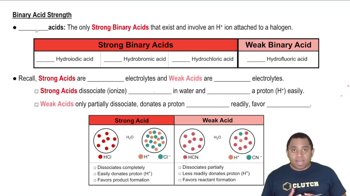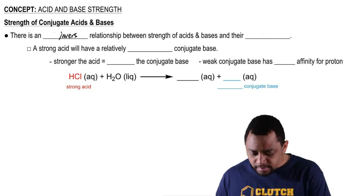Here are the essential concepts you must grasp in order to answer the question correctly.
Acid Strength
Acid strength refers to the ability of an acid to donate protons (H+) in a solution. Stronger acids dissociate more completely in water, resulting in a higher concentration of H+ ions. The strength of an acid is influenced by factors such as bond strength, electronegativity of the atoms involved, and the stability of the conjugate base formed after deprotonation.
Recommended video:
Electronegativity
Electronegativity is the tendency of an atom to attract electrons in a chemical bond. In the context of acids, higher electronegativity of the central atom typically leads to stronger acids, as it stabilizes the negative charge on the conjugate base after the acid donates a proton. For example, in the series HCl, H2S, and PH3, the electronegativity of chlorine is greater than that of sulfur and phosphorus, contributing to HCl's stronger acidic nature.
Recommended video:
Conjugate Base Stability
The stability of the conjugate base formed after an acid donates a proton is crucial in determining acid strength. A more stable conjugate base corresponds to a stronger acid, as the equilibrium favors the formation of the products. Factors affecting conjugate base stability include resonance, electronegativity, and the size of the atom bearing the negative charge. In the given compounds, the stability of the conjugate bases influences the order of acid strength.
Recommended video:
Strength of Conjugate Acids and Bases
 Verified step by step guidance
Verified step by step guidance


